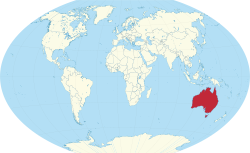Biology:Nymphaea carpentariae
| Nymphaea carpentariae | |
|---|---|
Script error: No such module "Conservation status".
| |
| Scientific classification | |
| Kingdom: | Plantae |
| Clade: | Tracheophytes |
| Clade: | Angiosperms |
| Order: | Nymphaeales |
| Family: | Nymphaeaceae |
| Genus: | Nymphaea |
| Species: | N. carpentariae
|
| Binomial name | |
| Nymphaea carpentariae S.W.L.Jacobs & Hellq.[1]
| |

| |
| Nymphaea carpentariae is native to Queensland and Western Australia[1] | |
Nymphaea carpentariae is a species of waterlily native to Queensland and Western Australia.[1]
Description
Vegetative characteristics
Nymphaea carpentariae is a perennial plant with 4 cm wide, globose to elongate rhizomes. The 45 cm wide, orbicular-elliptic leaves have dentate margins.[2]
Generative characteristics
The fragrant flowers rise up to 40 cm above the water surface. The androecium consists of 150-300 stamens. The gynoecium consists of 7-19 carpels. The 4 cm wide, globose fruits bear spherical too elongate-sherical, 2–3.5 mm long, and 2mm wide seeds with continuous rows of 0.1-0.15 mm long trichomes.[2]
Cytology
The chromosome count is n = ~42. The genome size is 1447.44 Mb.[3]
Taxonomy
Publication
It was first described by Surrey Wilfrid Laurance Jacobs and Carl Barre Hellquist in 2006.[1][4]
Type specimen
The type specimen was collected by Jacobs and Hellquist in Burketown, Queensland, Australia on the 18th of April 2005.[2][4]
Placement within Nymphaea
It is placed in Nymphaea subgenus Anecphya.[2]
Etymology
The specific epithet carpentariae references the Gulf of Carpentaria, Australia.[2]
Conservation
The NCA status of Nymphaea carpentariae is Special Least Concern.[5] According to the Western Australia Conservation status, it is a poorly-known species (P1).[6]
Ecology
Habitat
It is found in lagoons, and in billabongs.[2]
Cultivation
It has a named cultivar Nymphaea carpentariae "Julia Leu".[7][8]
References
- ↑ 1.0 1.1 1.2 1.3 "Nymphaea carpentariae S.W.L.Jacobs & Hellq." (in en). Royal Botanic Gardens, Kew. http://www.plantsoftheworldonline.org/taxon/77079797-1. Retrieved 29 December 2023.
- ↑ 2.0 2.1 2.2 2.3 2.4 2.5 Jacobs, S. W., & Hellquist, C. B. (2006). "Three new species of Nymphaea (Nymphaeaceae) in Australia." Telopea, 11(2), 155-160.
- ↑ Chen, F., Liu, X., Yu, C., Chen, Y., Tang, H., & Zhang, L. (2017). "Water lilies as emerging models for Darwin's abominable mystery." Horticulture research, 4.
- ↑ 4.0 4.1 Nymphaea carpentariae | International Plant Names Index. (n.d.). Retrieved December 29, 2023, from https://www.ipni.org/n/77079797-1
- ↑ Cite error: Invalid
<ref>tag; no text was provided for refs namedQueensland Government, 2022 - ↑ Australia, A. O. L. (n.d.). Species: Nymphaea carpentariae. Retrieved December 29, 2023, from https://bie.ala.org.au/species/https://id.biodiversity.org.au/node/apni/2916696
- ↑ Nymphaea carpentariae "Julia Leu." (n.d.). IWGS Plant Database. Retrieved December 29, 2023, from https://plants.iwgs.org/Home/PlantDetail?taxonID=132825
- ↑ WGI International Checklist of Nymphaea (Waterlily) Cultivars. (n.d.). Water Gardeners International. Retrieved December 29, 2023, from http://www.watergardenersinternational.org/checklist/carpentariae_julia_leu/form.htm
Wikidata ☰ Q17253172 entry
 |

